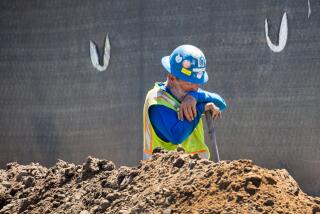Business Hurt as Big Chill Cuts Tourism
- Share via
Kim Main peered at the battle-gray skies above the Breezin surf shop in Ventura on Tuesday morning and passed judgment on a month of bad business in the Southland’s beach communities.
The weather, store co-owner Main said, “is just funky. . . . There’s no waves and no sun, and it’s cold.” Skies that call to mind Seattle, not Santa Monica, have “definitely had a big effect” on sales.
In sun-sensitive Southern California beach towns, overcast skies have meant sluggish sales of everything from visors to sunscreens. High daily temperatures for July at Los Angeles International Airport are averaging 72 degrees, compared to a historical average of 84 degrees. And, although the stubborn marine layer usually burns off by midday in inland areas, overcast skies often persist along the coast.
Coastal Southern California’s weather problems are part of an unseasonable weather picture that has afflicted most parts of the nation--with tangible economic effects. Until a thunderstorm hit late Tuesday, the Eastern Seaboard sweltered under temperatures reaching triple digits. Restaurants reported slack business as customers escaped the heat in climate-controlled homes and offices. But appliance stores did a land-office business in fans and air conditioners.
Consolidated Edison, the utility that provides electricity to New York and suburbs, reported that demand for electricity broke records Tuesday afternoon, before the rain came. Con Ed’s volume surged to “an all-time high,” spokeswoman Bea Meltzer said.
For Mitch Berliner, who distributes Good Humor ice cream products in Maryland, Virginia and the District of Columbia, super-high temperatures proved too much for his business. But he stands to gain from a break in the weather. “The best ice cream weather is between 75 and 85,” Berliner said.
Despite the break in the weather Tuesday, crop damage from days of withering heat in the Midwest caused futures prices for grains and oil seed to soar in hectic bull-market trading at the Chicago Board of Trade. Corn crops already have suffered irreversible damage from the searing temperatures, farmers and agricultural experts said.
“It went from a bumper crop to a bummer crop,” said Phil Nelson, a central Illinois farmer who said his farm has had no significant rain in eight weeks.
In Southern California, weather forecasters blame the lower coastal temperatures on a trough of low-pressure air that causes cool, damp conditions along the coast. That trough allows fog and low clouds to form, blocking the sun that usually brings out beach-goers and strollers in droves.
The less inviting weather is hurting coastal tourist stops as far north as Santa Barbara. For example, Frank Bacchilega, owner of Watersports, a kayak and windsurfing rental store, reported a 50% drop in customers this summer.
In July, 1990, Bacchilega said, he commonly earned several hundred dollars a day at his rental dock on the beach. Now, he said, he is happy to make $75 to $100.
And business is “definitely slower” for earring and accessory store owner Ann Collins. “There are not as many people on the boardwalk,” partly because of the cooler weather, she said. July weekends have been the worst, she said, with sales down about 25% to 35%.
Street merchants along the Venice boardwalk also report slower sales and smaller crowds. “There are fewer people, spending less money,” said Fariba, owner of Cafe Croissant, who would not give her last name. “Usually, at this time, Venice beach is full of kids and people.”
The moderate temperatures are occurring at a time when Southern California tourism already is hurting from the recession. But local officials said they won’t know the precise impact of the cooler weather until July economic figures for the region become available next month.
Forecasters do not expect the weather to improve quickly. According to Marty McKewon, a senior meteorologist with WeatherData Inc., which provides weather information to The Times, temperatures along the coast will be lower than average until perhaps mid-August.
“What you have right now is . . . a cool snap,” said Michael Schlesinger, a WeatherData forecaster. “We don’t see a heat wave in the future.”
The cooler days have been particularly troubling for businesses that are dependent on sunshine, like those that drive Catalina Island’s economy. Wayne Griffin, executive director of the Catalina Chamber of Commerce and Visitors Bureau, said he did not blame the slower business on the island wholly on the weather, “but there is no question that weather is a major factor.”
For “Dicho” Keough, an assistant manager at The Frog House surf shop in Newport Beach, the weather has been a bigger contributor to sluggish business. “Hideous,” he said of the stubborn marine layer that often refuses to burn off. “The weather has been nothing but garbage.”
The cooler weather and overcast skies have been doing “terrible things to the industry,” said Keough, whose beach business caters to the surfing crowd.
Young reported from Los Angeles and Zonana reported from New York.
More to Read
Inside the business of entertainment
The Wide Shot brings you news, analysis and insights on everything from streaming wars to production — and what it all means for the future.
You may occasionally receive promotional content from the Los Angeles Times.










